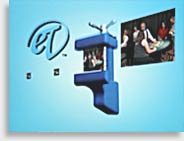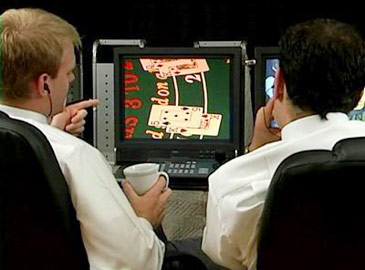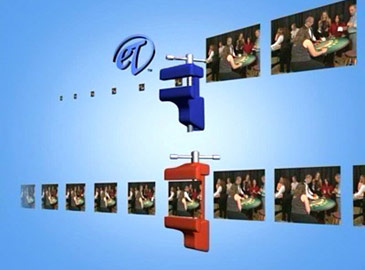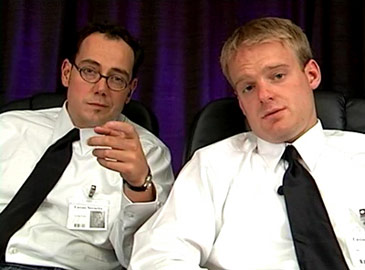|

I understand you recently finished working on
a video to promote GE’s new ClearCast system. What can
you tell me about ClearCast, and why a video?
What is Tivo?
I don’t get it—what does Tivo have to
do with ClearCast?
Tivo is a great product, but people just don’t get
it.
We face the same challenge with ClearCast. We know that
ClearCast is a digital video recording system. We know it
can capture
video from thousands of cameras. We know that it uses a new
compression technology that’s supposed to outperform
MPEG-4. But what does that mean to potential customers? ClearCast
should really change the way people think about digital recording
for security. If we didn’t get that across in the video,
we should re-edit it to make sure we did.
Video was an obvious
choice here because we wanted to show the difference in image
quality between images saved with the
ClearCast system and images saved using other forms of compression.
By the way, I know we’re
making this video [13.2MB]
available online (plus a couple of outtakes [5.6MB]),
and I want readers to know that they’re not going to
see the real image-quality difference here. We had to compress
the video significantly to make it small enough for an easy
download. Nobody wants to wait around for four-gigabyte download.
What do you think works particularly
well in the ClearCast video?
I’m really happy with the way we illustrated the
new video compression technology that makes ClearCast possible.
When
you have a technology edge and you’re relying on
it to help persuade customers to choose your product over
your competitors', you’ve got to be able to explain
the technology in a way that makes sense to them. They have
to understand
what the benefit is. Some people will get it just by reading
the text. Others need a picture. In the ClearCast video,
the dialog is right on and the graphics are right on. Together,
they tell a great story.

In
the ClearCast video, two security guards at a casino can
clearly tell what cards are played
on the blackjack table,
something they couldn’t do with ordinary video surveillance.
I notice that in the ClearCast video, you’ve
sandwiched the technical presentation between what look like
two 30-second spots.
I’ve been wanting to do this for a while. Often,
clients want a presentation that’s all about technology.
I don’t believe technology excites our client’s
customers.
I
also think it’s too easy to forget that our client’s
customers—engineers, surveyors and directors of security—are
people, too. When they put on their clothes to go to work
they don’t cover up their sense of humor and suddenly
become targets ready to consume messages packaged for engineers,
surveyors
and directors of security. They’re still people, and
when the day drags on at work, they get bored, they get tired
and they’re receptive to something that puts a smile
on their face—or even makes them laugh.
So do you think the ClearCast video is funny?
It’s not “ha, ha” funny. It’s droll.
What’s really funny is the outtake we shot where we
really dis one of GE’s competitors in the security
marketplace. You don’t get to say “This system
sucks ass”
too often in trade advertising. My buddy Eric Cartman helped
me write the script for that one.
How much did it cost to produce “Clearly”?
That’s not public information.
I’ve heard the
figure $1,000 per minute for video kicked around. How
accurate is that?
It’s not accurate at all. A lot of people we work with
have this $1,000-per-minute figure stuck in their heads.
I’m
not sure where it comes from. Maybe from the '50s. But I
doubt it was accurate even then. Maybe we’re adding
support for it by even mentioning it here.
What does it cost to do a video, per minute?
That’s actually the wrong question to ask, isn’t
it? I mean, you can hire a video production company to shoot
a three-hour meeting for $2 per minute. That’s just
to have a camera operator zoom in and out on the speaker and
occasionally pan across the audience. At the other extreme
you have the Honda “Cog” commercial.
Is that the two-minute
Rube Goldberg-like sequence?
Yeah. From what I understand it involved 606 takes and cost
$750,000. That’s $375,000 per minute.
So which is it,
$2 per minute or $375,000 per minute?
Neither. Every production is a mixture of several elements.
How you mix them is going to affect the cost.
It all
starts with a script. You need a scriptwriter who understands
your product and your audience (or who can
come up to speed quickly). You need a scriptwriter with a
good sense of pacing. You need a scriptwriter who has an
understanding
of production costs. (Fades in to car travelling along highway,
from camera mounted on forward boom we see driver looking
down at dashboard to read GPS. Cuts to view from camera on
rear
boom…)

Graphics
help explain how ClearCast’s eTreppid technology
compresses dynamic scenes much smaller than existing digital
video compression methods.
Then you consider graphics. If you decide to use graphics
to illustrate your technology or processes and you starve
the
graphics budget,
your video can end up looking like public-access television.
Not good if you’re promoting a high-end product.
And what about the talent? If your video is going to involve
any kind of acting, you have to use actors. This might seem
obvious,
but I’ve seen a lot of industrial videos where you
can tell they used company employees to do the acting, and
it’s
just awful. Again, it looks like public access television.
It doesn’t result in the kind of work that makes a
client’s
company look good.
Next, it’s amazing how much difference
good editing can make—right from the start. I’ve
come to rely on having the editor read over my scripts before
we start putting
together a shot list. Editors have a good feel for how much
time things take. I appreciate when mine says, “You’ve
got 30 seconds of voiceover here, but only 12 seconds of
image. How are we going to fill the hole?” The editor’s
also got access to all kinds of effects that—when used
properly—can really make your video. It’s amazing
what you can do with still images by zooming in and out or
panning across them slowly. (I think Apple actually calls
this the “Ken Burns Effect.”)
And, of course, direction. It would
take me more than the fingers I’ve
got on both my hands to count the number of videos I’ve
watched where a security guard raises his eyebrow, nods his
head or says, “I’ve got you now” when watching
a perpetrator. People just don’t do that kind of thing.
It’s the kind of thing that makes you go “Aw,
come on. You’re trying to sell this to me as a real
event, but this is obviously staged.” Poof—there
goes your credibility. Although this is partly the scriptwriter’s
responsibility, a good director will help you get the most
out of your actors
without resorting to cheap tricks.
OK. Back to my original question. How much?
You’re persistent.
We’ve produced videos for between
$10,000 and $75,000. But if somebody’s serious about
using video to showcase a product and its benefits, $30,000
to $50,000 will ensure
a well-produced piece that will put his or her company and
product in a favorable light. That would include writing
the script, auditioning and hiring talent, scouting locations,
performing two or three setups, shooting video, recording
voiceover
and editing. At the higher end, it would also include graphics
work.
What's your favorite part of the process?
Working with talent is one of the most fun parts of the whole
process. Actually, I should say auditioning the talent is
one of the most fun parts of the whole process. You walk
into the talent agency and drink coffee while you watch the
actors
read parts of your script or improvise from a scenario you
give them. When they leave the room, you judge them.
It’s
easy to see why people get addicted to this.

The actors playing the casino security guards help set the
tone at the beginning of the video and wrap up the story
at the end.
So, is the ClearCast
video worthy of a Telly?
I wouldn’t know. Really the only kind of recognition
I care about is acceptance by the audience—and our
client’s
profitability. Right now we’re getting ready to send
out Version 1 of the ClearCast video as part of a direct
marketing campaign to Native American Casinos. If that campaign
results in just half a dozen casinos specifyng the ClearCast
system,
we’ll be successful.
|



